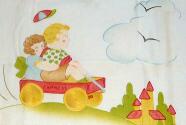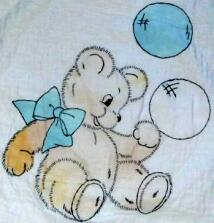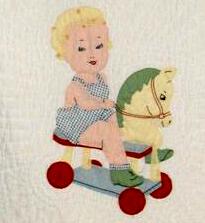Heavens to Betsy! We are seeing Stars
Carol Gebel says, “Stars are fun but not simple.” Is that ever an understatement!
Disclaimer: After extensive research on star quilt
patterns, I have discovered there are almost as many different opinions on
names and dates of origin as there are designs. The following data: dates,
names, etc. has come from various “knowledgeable sources” about quilts and
quilting. However, as you may soon realize they differ in their opinions
and facts sometimes to a great degree. Read this and enjoy and if you have
a different take on something I am always interested in learning more. I
have listed several names, periodicals and web sites at the end so peruse
them as you wish.
Respectfully,
Judi Fibush
Brief History of Star Quilts
About the mid nineteenth century the first commercial cotton fabric became available. In the 1830s American textile mills began to produce tremendous quantities of cotton fabric which made quilt making more creative. Commercial fabric was available in more limited quantities in the U.S. before the 1830s and even earlier in greater quantities in Great Britain. Before the 1830s much of the fabric used in American quilts was imported from England and France in particular. In fact Britain "dumped" a lot of fabric into the American market after the war of 1812. Industrialization of British textile mills started in the late 1700s.
This availability of American textiles aided in producing the one large lone star that covers most of the top of a quilt. Variations of the star would appear with 4, 5, 6 and 8 points. However, there are basically 2 categories of stars, each with 2 major subdivisions: those using diamonds, 6 point stars and 8 point stars; and those using only squares and triangles, i.e. Variable stars and Ohio stars. Variable stars are a 4 patch (or 16 patches) pattern and Ohio stars are a nine-patch pattern.
Most star blocks are constructed in the traditional design of an eight-pointed star made of diamond pieces. It is patterned with bands of color radiating from the center of the star out to the points.
The Mathematical Star was the earliest name for a star pattern that came from the Baltimore area. This name expanded to Star of Bethlehem, Morning Star, Lone Star and Star of the East depending upon the geographical area where it was made and the religious beliefs of its makers.
The Lone Star came from the symbol for the state of Texas just before the Alamo in 1845.
The Morning Star is usually related to the Plains Indians who were introduced late in the 1800s to quilt making by the missionaries. However, the Morning Star was a motif that the Indians used early on their animal hides for clothing and bedding. It represented the morning star of Venus which was part of their religious practices.
Blazing Star is the Star pattern made much smaller to incorporate many stars on a top.
Touching Stars have four points which are touching another star.
Broken Star is a large lone star that is placed inside of a curved set of similar diamond shape blocks that encircle it and form half-stars.
Feathered Star is the most difficult and intricate of the star patterns. It is made with 8 points made of two types of triangles of various sizes.
Ohio Star is a 9 patch block with a central square which could be further subdivided and surround by 8 pointed triangles.
The Sawtooth or Variable Star is based on the 16 patch block with one square in the center.
The LeMoyne Star is an 8 pointed star made up of 45 degree angle diamonds. It is named after the LeMoyne brothers who founded New Orleans in 1718.
Amish began making quilts around 1870 but didn’t incorporate the star in their quilts until later.
African Americans were making utilitarian quilts during the Civil War most of which never survived and it wasn’t until the 1920s that stars would occasionally appear in their quilts.
Pattern Names with Dates of Origin
NOTE: “While the early examples didn't have names as we know them, these style names developed approximately after the Civil War. In the late 1880s quilting was becoming a business. The need for names to enhance the marketing ability of patterns, old designs and new were given a variety of names.”
The Ladies Art Company started producing patterns in 1895. “All documentation found so far points to the fact that the Ladies Art Company was established in 1889. Magazine ads in 1895 mentioned 272 quilt blocks to choose from and a catalog was published in 1897 listing 400 different blocks.” This was the first company to produce a catalog.
Dawn Duperault’s website under the name “reddawn” shows the following names and dates for various star quilt patterns. It is difficult to ascertain who is correct in the confusing data from just these 2 sources and many others differ too. So do not take the following data as absolutely correct.
Quilts relating to religion: Star of Bethlehem, Morning Star, Star of the East
Quilts relating to nature: Blazing Star, Star Burst
Quilts with patriotic or political themes: Dolly Madison's Star, Martha Washington’s Star, Patriotic Star, Texas Star
1815 - Eight-pointed Star, Sawtooth Star, Ohio Star
1830 - Feathered Star, Lone Star, Star of Bethlehem, Rising Sun
1834 - LeMoyne Star, Texas Star, Blazing star
1855 - Sunburst, Star burst
1876 - Ellen Baker’s Solar System Quilt
References/Acknowlegements
Thanks to various quilt historians and experts for leading to the above data. They are Barbara Brackman, Judy Anne Breneman, Barbara Garrett, Carol Gebel, Stacy Hollander, Martha Mccloskey, Sue Wildemuth, Kimberly Wulfert, and AQSG “Undercoverings” .
Websites to Peruse
http://www.ladiesartcompany.com/history.htm
http://www.womenfolk.com/quilt_pattern_history/mornstar.htm
http://historyexplorer.si.edu/resource/?key=5146&lp=artifacts
Composed By
Judi Fibush, quilt enthusiast and member of AQSG



